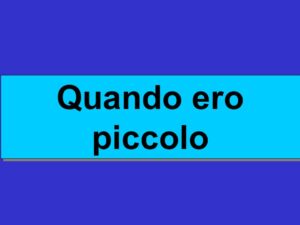
The present perfect is used to speak in the past and is a compound tense, that is, made up of 2 words.
Present indicative of the auxiliary (to be or to have) + Past participle of the verb
How the present perfect is formed
In the present perfect, the 1st word is the present of the verb essere or avere, while the 2nd word is the past participle of the main verb.
The past participle of the verb “essere” is → stato
The past participle of the verb “avere” is → avuto
The past participle of regular verbs in –ARE is formed by adding the ending –ato. Example: studiare → studiato.
The past participle of regular verbs in -ERE is formed by adding the ending -uto. Example: tenere →tenuto.
The past participle of regular verbs in -IRE is formed by adding the ending -ito. Example: dormire → dormito.
You may also find irregularities in the past perfect. If you want to find out what they are and practice the past tense while having fun, we suggest you study the topic in one of our individual grammar lessons: https://chiaratheitalianteacher.com/individual-lessons/
To be or to have in the present perfect

When we use avere to form the present perfect, the past participle does not change and does not agree in gender and number with the subject that performs the action.
Examples: Sara ate early last night. Mario and Sandra slept late over the weekend. Luigi talked to his wife about his vacation = Sara ha mangiato presto ieri sera. Mario e Sandra hanno dormito fino a tardi nel fine settimana. Luigi ha parlato con sua moglie delle vacanze.
When we use essere to form the present perfect, the past participle always agrees in gender and number with the subject that performs the action.
Examples: Chiara went to a restaurant with Fabio. Laura and Monica left for the United States last night. Luca and Paolo arrived late at the cinema = Chiara è andata al ristorante con Fabio. Laura e Monica sono partite ieri sera per gli Stati Uniti. Luca e Paolo sono arrivati tardi al cinema.
To form the present perfect, most verbs in Italian use the verb avere as the first word.
The 4 groups of verbs that form the present perfect with ESSERE
There are 4 groups of verbs that form the present perfect with the verb essere. Let’s see what they are!
1. Verbs of movement
These are verbs that indicate that your body moves in space. Here are some of the verbs of movement that are meant to form the past perfect and that you can learn by heart:
- Andare(go) → sono andato/a
- Venire (come) → sono venuto/a
- Salire (go up) → sono salito/a
- Scendere (go down) → sono sceso/a
- Cadere (fall) → sono caduto/a
- Partire (leave) → sono partito/a
- Entrare (enter → sono entrato/a
- Uscire (go out) → sono uscito/a
- Tornare (come back) → sono tornato/a
- Arrivare (arrive) → sono arrivato/a
2. Verbs that do not indicate any movement
These are verbs that have the meaning of “to stay still in one place” (STAY):
- Stare (stay) → sono stato/a
- Rimanere (stay) → sono rimasto/a
- Restare (stay) → sono restato/a
3. Verbs of change
All those verbs that indicate a transformation or a change in the subject who performs the action:
- Crescere (grow) → sono cresciuto/a
- Diventare (become) → sono diventato/a
- Nascere (be born) → sono nato/a
- Morire (die) → sono morto/a
4. Reflexive verbs
All reflexive verbs as:
- Lavarsi (wash yourself) → mi sono lavato/a
- Vestirsi (dress yourseld) → mi sono vestito/a
- Pettinarsi (comb your hair) → mi sono pettinata/a
If the verb is not in these 4 groups, you can most likely form the past perfect with the verb avere.
Conclusion
As you well know, Italian has many exceptions and you may find many of them also for the present perfect. If you try to follow the rule of the 4 groups to form the present perfect with the verb essere and all the others with avere, you will surely make very few mistakes.
If you want to practice the present perfect and many other grammar rules, book a package of individual lessons by visiting our website: https://chiaratheitalianteacher.com/individual-lessons/
Leave your comment if you liked this article and it was useful to understand how to form the present perfect in Italian



